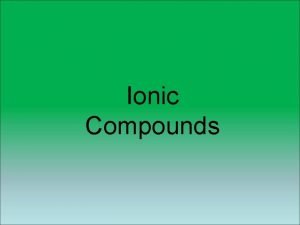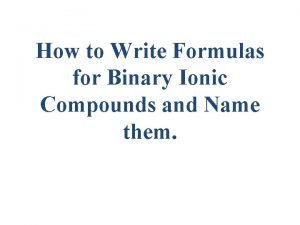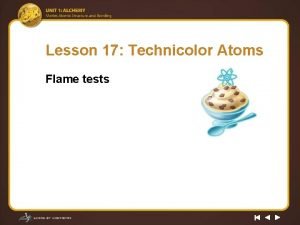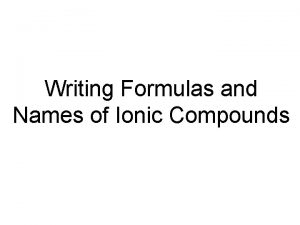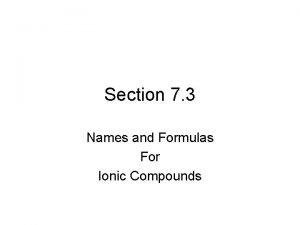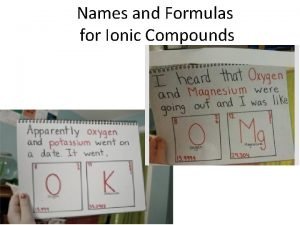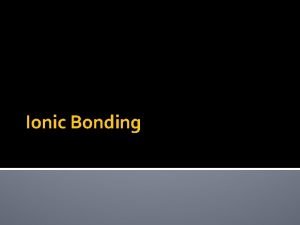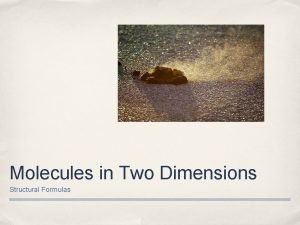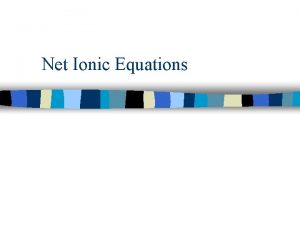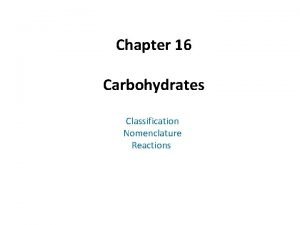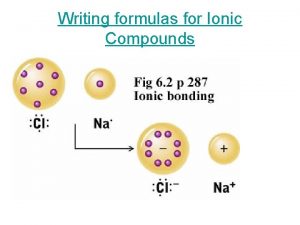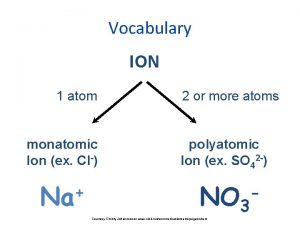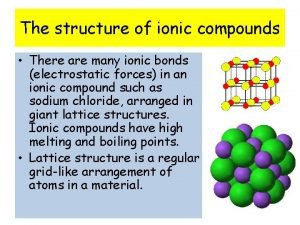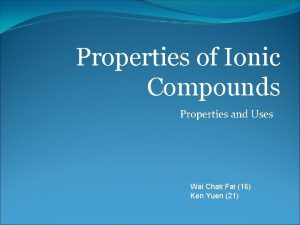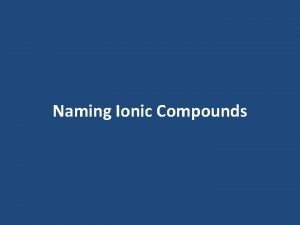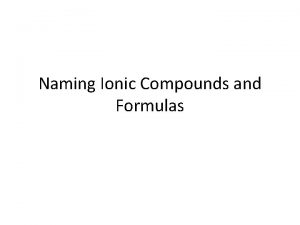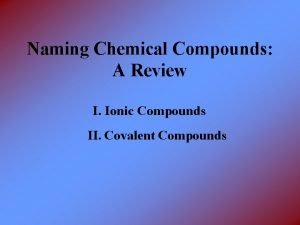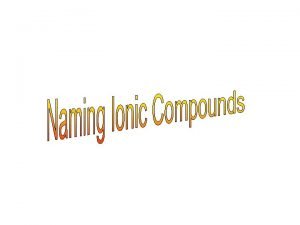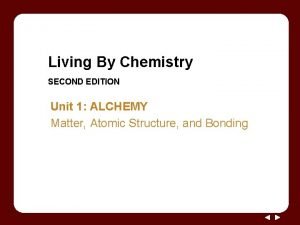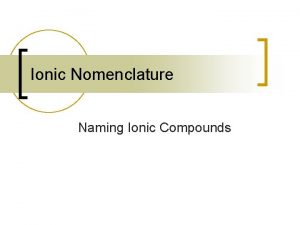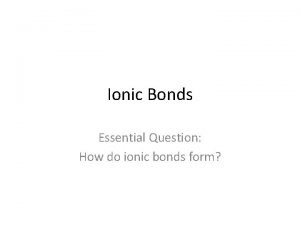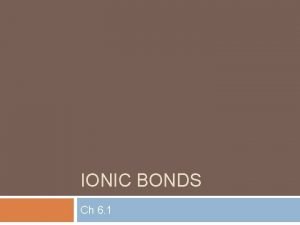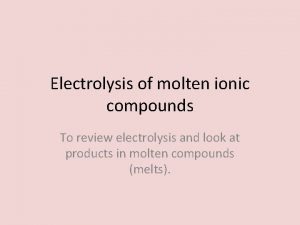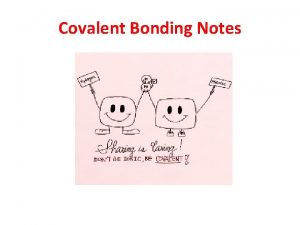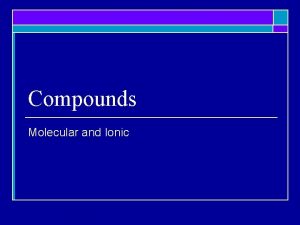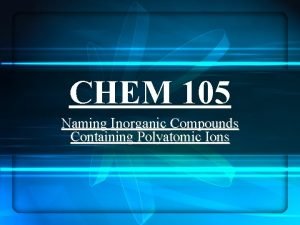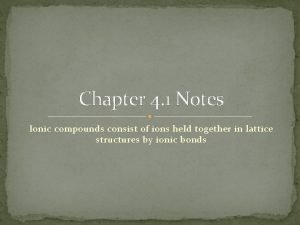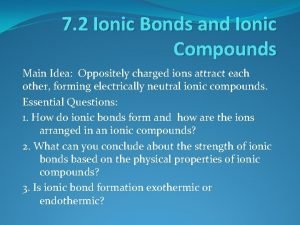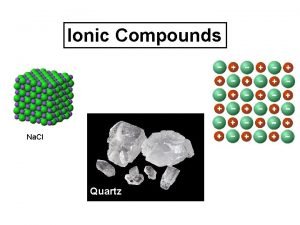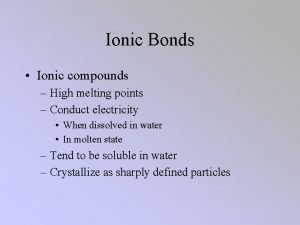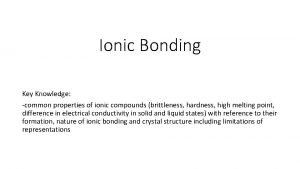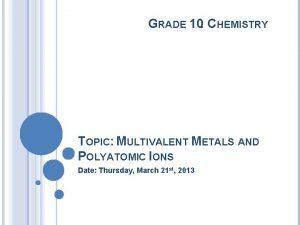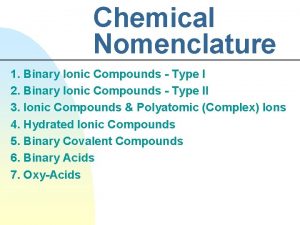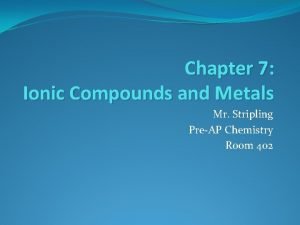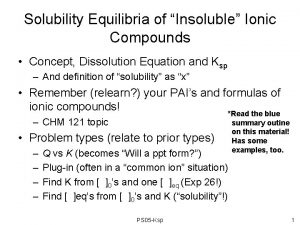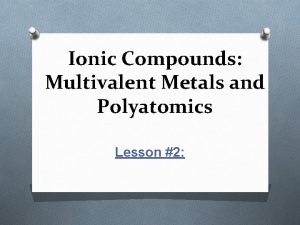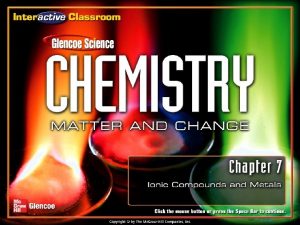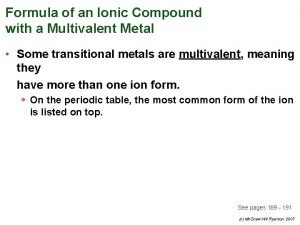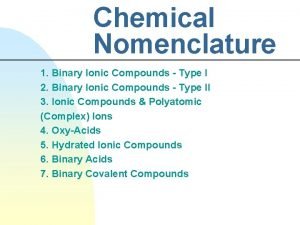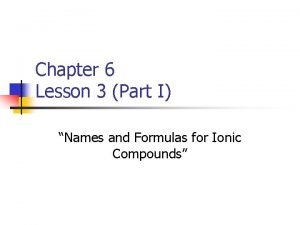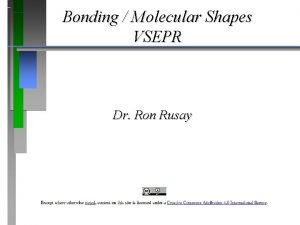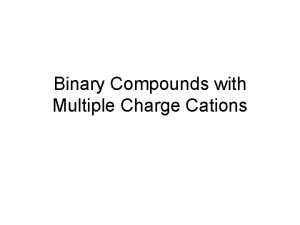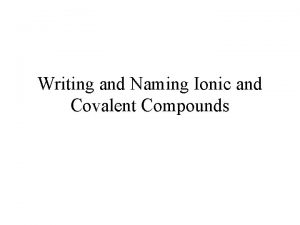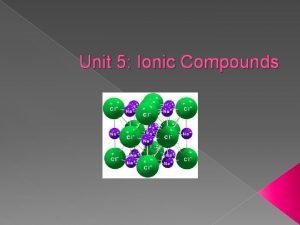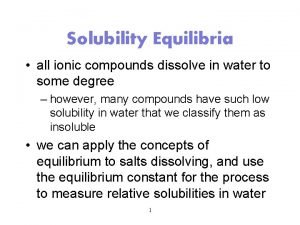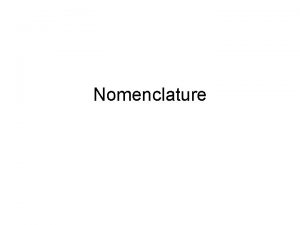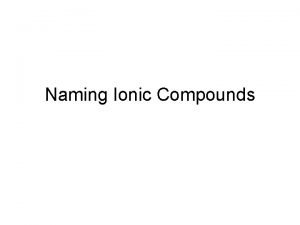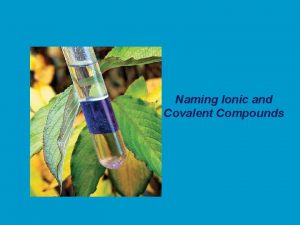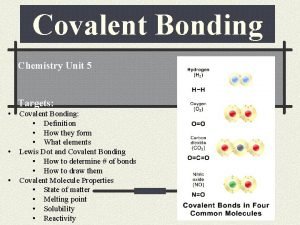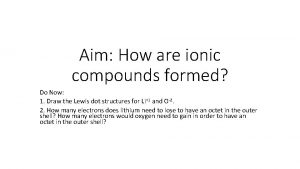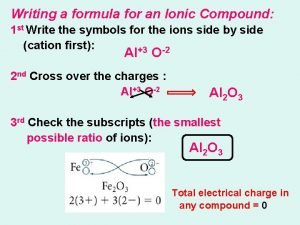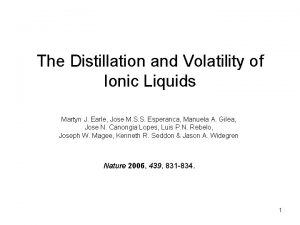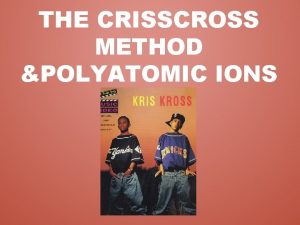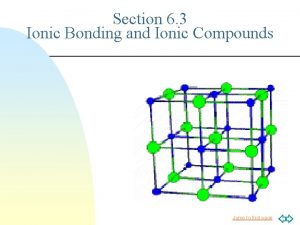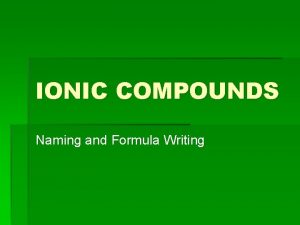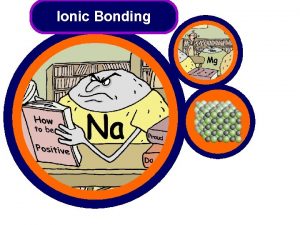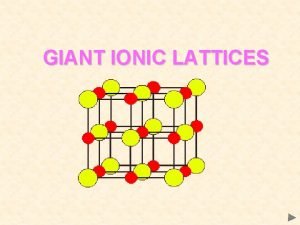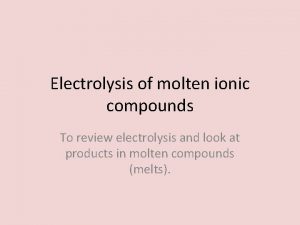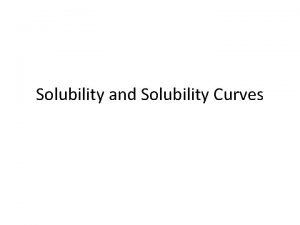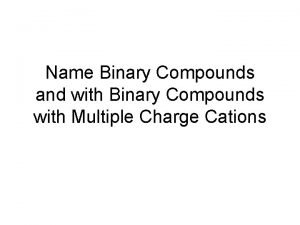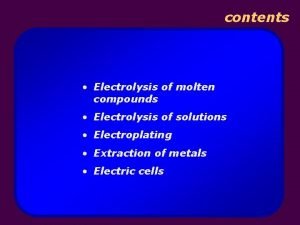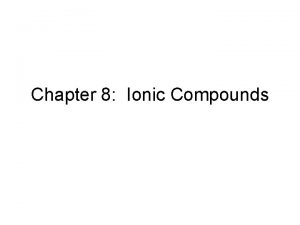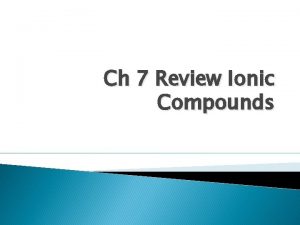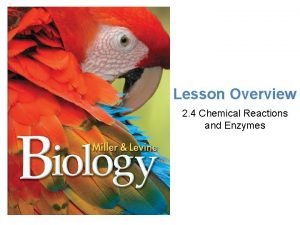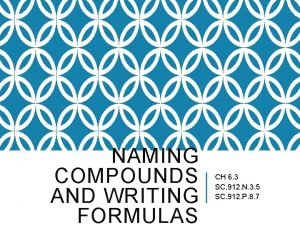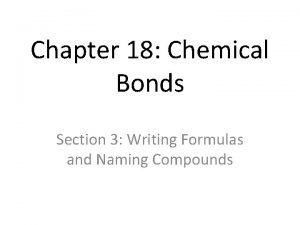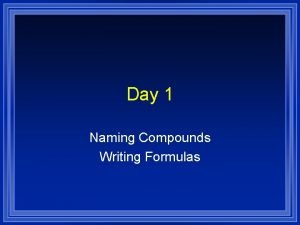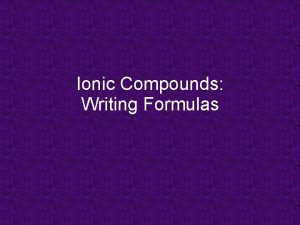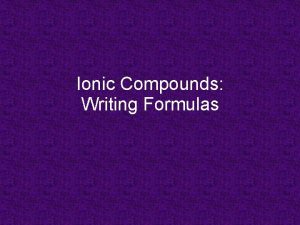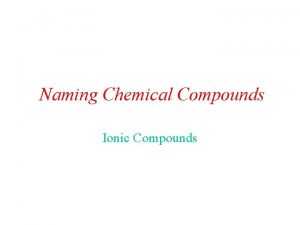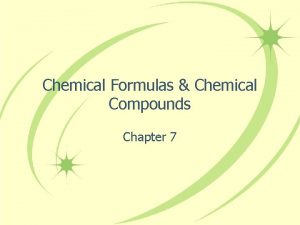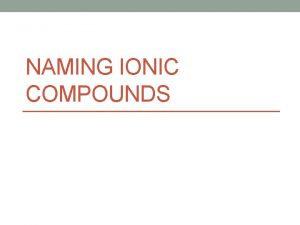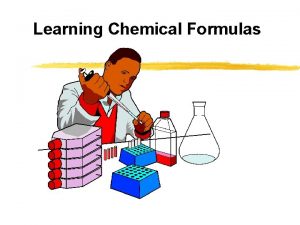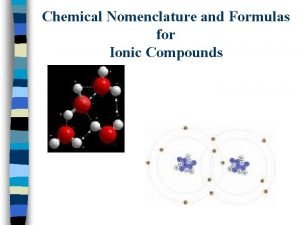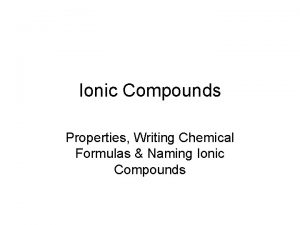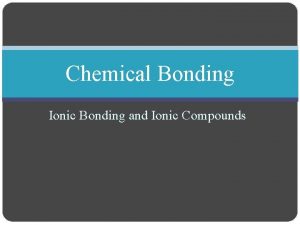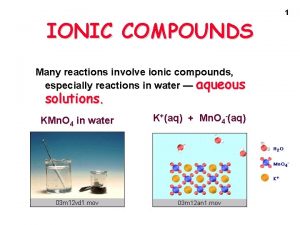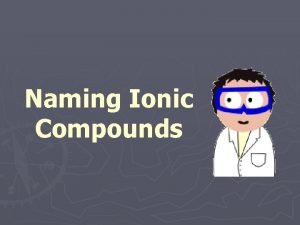Molecules Compounds Chemical Reactions Overview Compounds Formulas Ionic





































































































- Slides: 101

Molecules, Compounds & Chemical Reactions Overview • Compounds – Formulas – Ionic compounds – Molecular (covalent) compounds • Molecular weight/molar mass • Covalent Bonds – Bonding models: Lewis, VSEPR, etc. – Molecular geometry and chemical properties • Chemical reactions – Balancing equations – Molar relationships

Chemical Representations Representational: chemical formulas, equations CH 4 + 2 O 2 CO 2 + 2 H 2 O Chemistry Submicroscopic: atoms, molecules Macroscopic: experimental

Compounds • Atoms are typically bound together in molecules • Noble gases exist as individual atoms, most other elements found as compounds • More stable – Forming a bond: releases energy, less stable to more stable – Breaking a bond: requires energy, more stable to less stable (misconception)

Chemical Formulas Ax. By. Cz A, B, C = elemental symbols x, y, z = relative number of atoms in molecule Problem 1: How many of each atom are in the following molecules? a) b) c) C 6 H 12 O 6 (glucose) NH 3 (ammonia) Na. HCO 3 (baking soda)

Problem 1: How many of each atom are in the following molecules? a) C 6 H 12 O 6 b) NH 3 c) Na. HCO 3 (baking soda)

Problem 1: How many of each atom are in the following molecules? a) C 6 H 12 O 6 6 carbons, 12 hydrogens, 6 oxygens b) NH 3 1 nitrogen, 3 hydrogens c) Na. HCO 3 (baking soda) 1 sodium, 1 hydrogen, 1 carbon, 3 oxygens

Ionic Compounds • Ionic compounds are made up of ions held together by electrostatic forces: ionic bonds • Cation (+) & anion (–) • Cation (metal) + anion (nonmetal: monatomic or polyatomic) Na+ + Cl– Na. Cl

Crystal Lattice—Na. Cl: ratio of atoms in the lattice

Ionic Compounds • Dissociate when they dissolve in water Na. Cl water Na+(aq) + Cl–(aq)


Ionic Compounds Monatomic ions: Cation: group number Li+, Na+, K+, Rb+, Cs+ Mg 2+, Ca 2+ Al 3+ Transition metals often variable: Cu 2+, Cu+ (copper II and copper I) and Fe 3+, Fe 2+ (iron III and iron II)

Ionic Compounds Monatomic ions: Anion: 8 – group number add to electrons to make 8 (octet) O O 2– oxide S S 2– sulfide Cl Cl– chloride P P 3– phosphide

Ionic Compounds Balance anion with cation to a neutral charge: magnesium oxide: Mg 2+ with O 2– Mg. O aluminum chloride: Al 3+ with Cl– Al. Cl 3

Problem 2 Write the ionic formulas for each of the following: a) The compound that magnesium makes with chlorine b) The compound that Fe 3+ makes with oxygen c) Sodium fluoride d) Cesium oxide e) Copper (I) sulfide

Problem 2 Write the ionic formulas for each of the following: a) The compound that magnesium makes with chlorine Mg. Cl 2 b) The compound that Fe 3+ makes with oxygen Fe 2 O 3 c) Sodium fluoride Na. F d) Cesium oxide Cs 2 O e) Copper (I) sulfide Cu 2 S

Polyatomic Ions CO 32– carbonate ion Travels as a unit (Texans) Na 2 CO 3 sodium carbonate Fe 2(CO 3)3 iron (III) carbonate

Common Polyatomic Ions nitrate NO 3– nitrite NO 2– sulfate SO 42– sulfite SO 32– phosphate PO 43– carbonate CO 32– hydroxide OH– ammonium NH 4+

Problem 3: Write the ionic formulas for each of the following: a) Magnesium phosphate b) Ammonium carbonate c) Sodium sulfite Problem 4: Write the names for the following: a) Na. NO 3 b) K 2 SO 4 c) Fe. PO 4

Problem 3: Write the ionic formulas for each of the following: a) Magnesium phosphate Mg 2+ with PO 43– Mg 3(PO 4)2 b) Ammonium carbonate NH 4+ with CO 32– (NH 4)2 CO 3 c) Sodium sulfite Na+ with SO 32– Na 2 SO 3

Problem 4: Write the names for the following: a) Na. NO 3 sodium nitrate b) K 2 SO 4 potassium sulfate c) Fe. PO 4 iron (III) phosphate

Covalent Compounds • Two or more nonmetals typically bond in covalent bonds • Sharing of electrons (not always equal sharing) • Molecular formula: actual atoms in molecule (rather than ratio) • C 6 H 12 O 6: glucose • CH 2 O: formaldehyde • Molecular formula correlates to molar ratio

Molecular Formula H 2 O 2 H’s and 1 O per molecule 500 H 2 O molecules: How many H’s? 1000 H atoms How many O’s? 500 O atoms Problem 5 a) How many Cl atoms are in 40 CCl 4 molecules? b) How many C atoms are in 30 C 6 H 12 O 6 molecules? How many H atoms? How many O atoms?

Problem 5 a) CCl 4 40 molecules CCl 4 4 x 40 = 1 x 160 Cl atoms = 160 Cl atoms

Problem 5 b) C 6 H 12 O 6 30 molecules C 6 H 12 O 6 have = 360 H atoms 30 molecules C 6 H 12 O 6 have = 180 O atoms = 180 C atoms

Problem 6 a) How many moles of H are in 5. 0 moles of BH 3? b) How many moles of Cl are in 12. 0 moles of C 2 H 4 Cl 2?

Problem 6 a) How many moles of H are in 5. 0 moles of BH 3? b) How many moles of Cl are in 12. 0 moles of C 2 H 4 Cl 2? a) 5. 0 mol BH 3 b) 12. 0 mol C 2 H 4 Cl 2 = 15. 0 mol H = 24. 0 mol Cl

Covalent Bonding • Sharing of valence electrons • Non-metals • Many models – Lewis structures: number and types of bonds – VSEPR (valence shell electron pair repulsion): empirical model that predicts molecular geometry – Valence Bond model: describes nature of bonds and predicts reactivity – Molecular Orbital theory: gold standard of understanding bonding, but requires high level of mathematics (calculus, group theory)

Bonding Why do bonds form? A+B vs. A—B lower E higher E NO BOND higher E lower E BOND

Bonding Why do bonds form? A+B vs. A—B lower E He + Cl higher E vs. He—Cl NO BOND

Bonding Why do bonds form? A+B vs. A—B lower E He + Cl higher E vs. He—Cl NO BOND

Bonding Why do bonds form? A+B vs. A—B higher E lower E H + Cl vs. H—Cl preferred BOND

Valence electrons 1 e– 2 e– 3 e– 4 e– 5 e– 6 e– 7 e– 8 e– H He Li Be B C N O F Ne Na Mg Al Si P S Cl Ar

Lewis “dot” structures F F– 7 valence electrons 8 valence electrons Ne F F N N 3– 5 valence electrons 8 valence electrons N N Put electrons in singly b/f pairing: C N Ne

Problem 7 How many valence electrons would you expect each of the following to have? Draw a Lewis structure for each one. a) Sr b) Se c) I (iodine) d) K e) Cs

Problem 7 a) Sr: 2 valence electrons Sr b) Se: 6 valence electrons Se c) I: 7 valence electrons I d) K: 1 valence electron K e) Cs: 1 valence electron Cs

Problem 8 Draw Lewis dot structures for a) C b) P c) P 3– d) Se 2–

Problem 8 a) C: 4 valence electrons C b) P: 5 valence electrons P c) P 3–: 8 valence electrons P d) Se 2 -: 8 valence electrons Se

Covalent Bonding • Sharing of electrons H O H O H H H 2 O

Covalent Bonding • Sharing of electrons H O H like Ne

Covalent Bonding • Sharing of electrons H O H like He

Covalent Bonding • Nonmetal + nonmetal H C

Covalent Bonding • Nonmetal + nonmetal H H CH 4

Problem 9 Write the Lewis structure for each atom in the group of atoms given. Then figure out how they might bond together covalently to form a stable compound (octet/duet). a) C, Cl, F, Cl, H (central C atom) b) N, 2 H’s, Cl (central N atom) c) P and H (use as many H’s as you need) d) 2 C’s and 6 H’s e) O, F, H (central O)

Problem 9 a) C Cl F F Cl C H Cl

Problem 9 b) N Cl H

Problem 9 b) N Cl N H H Cl—N —H H

Problem 9 c) P H H + 3 x H H—P —H H

Problem 9 d) C C H H H H H–C –C –H H H

Problem 9 e) O F F O H H H–O –F

Multiple bonds Some atoms form double and triple bonds C 2 H 4 C H H H

Multiple bonds C 2 H 4 H C C H H H

Multiple bonds C 2 H 4 H C C H H H

Multiple bonds C 2 H 4 H C H H

Multiple bonds C 2 H 4 H C H H H–C C–H H H

Multiple bonds triple bonds C 2 H 2 C H

Multiple bonds C 2 H 2 H C C H

Multiple bonds C 2 H 2 H C C H

Multiple bonds C 2 H 2 H C C H

Multiple bonds C 2 H 2 H C C H H–C C–H

Covalent Bonds Atom… has… C, Si N, P O, S, Se F, Cl, Br, I 4 valence electrons 5 valence electrons 6 valence electrons 7 valence electrons typically forms… 4 bonds 3 bonds 2 bonds 1 bond

Problem 10 Draw the Lewis structure for each of the atoms in the formula below. Then draw the Lewis structure for the molecule. a) HCN (central C) b) CH 2 O (central C) c) C 2 Cl 2 d) HNO (central N)

Problem 10 a) H C N

Problem 10 a) H H C C N N

Problem 10 a) H H C C N H C N N H–C N

Problem 10 b) H H C O H H–C=O

Problem 10 c) Cl C C Cl Cl–C C–Cl

Problem 10 d) H N O

Problem 10 d) H H N O H–N=O

Molecular Geometry (VSEPR) Valence Shell Electron Pair Repulsion Electron bonding pairs repel each other Adopt geometry to maximize their separation distance. Treat multiple bonds as if they were single electron pair. CH 4 tetrahedral 109. 5°

Tetrahedral Carbon Anytime carbon is bonded to four other atoms, it has tetrahedral geometry. So H 3 C–CH 2–CH 2–CH 2–CH 3 is really

VSEPR 2 electron pairs: linear http: //www. d. umn. edu/~pkiprof/chemweb/VSEPR/ CO 2 O=C=O

VSEPR 3 electron pairs 3 bonding: trigonal planar H–B–H H link

4 electron pairs link H 4 bonding: tetrahedral H–C–H H 3 bonding (1 nonbonding): trigonal pyramid H–N–H H 2 bonding (2 nonbonding): “bent” or nonlinear H–O–H

Problem 11 Given the following Lewis structures, predict the three dimensional molecular geometry. • • a) H–N–Cl • • Cl • • b) • • Cl–S • • Cl • •

Problem 11 a) Trigonal pyramid N H Cl b) Bent or Nonlinear S Cl Cl Cl

Multiple Bonds in VSEPR Treated like single bonds H–C–H O Trigonal planar 120°

Problem 12 Given the following Lewis structures, predict the three dimensional molecular geometry. Draw a picture of the molecule. a) H–C N • • b) • • O=N–H • • c) H–C=C –H H H

Problem 12 a) H–C N Linear ·· b) O=N–H ·· O H

Problem 12 c) H–C=C–H H H

e– Formula regions B NB e – geom Molec. Geo. Bond angles 2 AX 2 2 0 linear 180º 3 AX 3 3 0 Trig. planar 120º 3 AX 2 2 1 Trig. planar Bent 120º 4 AX 4 4 0 Tetrahedral 109. 5º 4 AX 3 3 1 Tetrahedral Trig. pyram. 109. 5º 4 AX 2 2 2 Tetrahedral Bent 109. 5º

Polar and Nonpolar Covalent Bonds Equal sharing of electrons: C—C C C Ionic bonds: Na+ Cl– Complete transfer of electrons

Polar Covalent Bonds Unequal sharing of electrons H—Cl Different electronegativity Cl is more electronegative than H Electronegativity: ability to attract electron density in a covalent bond

Polar Covalent Bonds Unequal sharing of electrons H Cl H—Cl Area of low electron density + – H—Cl Area of high electron density

Polar Covalent Bonds

Problem 13 Which of the following pairs of atoms is the more electronegative? P or F Sr or Si Se or Cs

Problem 13 Which of the following pairs of atoms is the more electronegative? P or F Sr or Si Se or Cs

Problem 14 Indicate the polarity of the following bonds using the + and ‑ symbolism. a) C O b) N P c) Br F

Problem 14 Indicate the polarity of the following bonds using the + and ‑ symbolism. + – a) C O – + b) N P + – c) Br F

Molecular Polarity Polar bonds that cancel nonpolar molecule + – O=C=O – Overall molecule: nonpolar Polar bonds that do NOT cancel polar molecule – O + H H + Polar molecules dissolve other polar molecules (some ionic compounds Nonpolar molecules dissolve other nonpolar molecules

Chemical Reactions • Chemical reactions occur when bonds break and reform in different arrangements • Can absorb or release heat • Overall energy needs to be “downhill” (more stable products)

Chemical Equations (Reactions) No coefficient: assume it is 1 Designates the total number of H 2 molecules that react N 2 + 3 H 2 2 NH 3 reactants Designates the atoms of N in each molecule product(s) Designates the atoms of H in each molecule Ratio of N: H is 1: 3 in product molecule Total molecules of product formed: 2

Chemical Equations CH 4 + O 2 CO 2 + H 2 O reactants products Number and type of atoms on each side must be equal (balance) CH 4 + O 2 CO 2 + H 2 O 1 C 4 H 2 O 1 C 2 H 3 O

Chemical Equations CH 4 + O 2 CO 2 + H 2 O reactants products Number and type of atoms on each side must be equal (balance) CH 4 + O 2 CO 2 + 2 H 2 O 1 C 4 H 4 O

Chemical Equations CH 4 + O 2 CO 2 + H 2 O reactants products Number and type of atoms on each side must be equal (balance) CH 4 + 2 O 2 CO 2 + 2 H 2 O 1 C 4 H 4 O balanced Can only change coefficients Cannot change molecular formula

Chemical Equations as Conversion Factors 2 Fe + O 2 2 Fe. O If we start with 2. 0 mol of Fe, how many moles of O 2 do we need, and how many moles of Fe. O are produced? If we start with 4. 0 mol of Fe, how many moles of O 2 do we need, and how many moles of Fe. O are produced? 4. 0 mol Fe = 2. 0 mol O 2 4. 0 mol Fe = 4. 0 mol Fe. O

The Mole • Chemists use “moles” as a way to count atoms • Molar ratio corresponds to ratio of atoms and molecules in balanced equation • Mole (and thus molecules) linked to laboratory by mass in grams and molar mass (molecular weight)

Gram to Mole Conversions Grams molar mass = moles Moles x molar mass = grams How many moles in 35. 5 g of PCl 3? 35. 5 g Ratio method: = 0. 260 mol

Gram to Mole Conversions Grams molar mass = moles Moles x molar mass = grams How many grams is 6. 50 mol of PCl 3? 6. 50 mol = 892. 6 g

Problem 15 a) Calculate the number of moles in 24. 4 g of H 2. b) If the H 2 reacts with oxygen to make hydrogen peroxide: H 2 + O 2 H 2 O 2 How many moles of H 2 O 2 will form? c) How many g of H 2 O 2?

Problem 15 a) number of moles in 24. 4 g of H 2. 24. 4 = 2. 02 (x) x = 12. 1 mol 24. 4 g = 12. 1 mol H 2 b) H 2 + O 2 H 2 O 2 How many moles of H 2 O 2 will form? 1: 1 ratio 12. 1 mol H 2 O 2

Problem 15 c) How many g of H 2 O 2? 12. 08 mol H 2 O 2 (2(1. 01 g/mol) + 2(16. 00 g/mol)) 34. 02 g/mol 12. 08 mol H 2 O 2 (34. 02 g/mol) = 411 g H 2 O 2
 Section 2 classifying chemical reactions
Section 2 classifying chemical reactions Chemical reactions section 2 classifying chemical reactions
Chemical reactions section 2 classifying chemical reactions Chemical formulas and names
Chemical formulas and names Empirical formula pogil
Empirical formula pogil Love formula
Love formula Non metals examples
Non metals examples Chemical reactions section 3 reactions in aqueous solutions
Chemical reactions section 3 reactions in aqueous solutions How to write formulas for ionic compounds
How to write formulas for ionic compounds Lesson 17 technicolor atoms flame test answers
Lesson 17 technicolor atoms flame test answers Monatomic ion definition chemistry
Monatomic ion definition chemistry Writing formulas from names
Writing formulas from names Section 3 names and formulas for ionic compounds
Section 3 names and formulas for ionic compounds Section 3 names and formulas for ionic compounds
Section 3 names and formulas for ionic compounds Ionic, covalent and metallic bonds venn diagram
Ionic, covalent and metallic bonds venn diagram Writing formulas (crisscross method)
Writing formulas (crisscross method) Ionic bonding problems
Ionic bonding problems Chemical reactions section 1 chemical changes
Chemical reactions section 1 chemical changes Are kc and kp equal
Are kc and kp equal Organic molecules vs inorganic molecules
Organic molecules vs inorganic molecules Molecules in two dimensions structural formulas
Molecules in two dimensions structural formulas Redox half reactions
Redox half reactions Chemistry unit 5 reactions balancing reactions worksheet
Chemistry unit 5 reactions balancing reactions worksheet Study jams mixtures
Study jams mixtures All compounds are molecules
All compounds are molecules Science prof online
Science prof online How to find net ionic equation
How to find net ionic equation Reactions of organic compounds
Reactions of organic compounds Ternary ionic compounds
Ternary ionic compounds Monatomic element example
Monatomic element example Ionic compound brittle
Ionic compound brittle Ksp and keq
Ksp and keq Ionic compound
Ionic compound Cl-1 ion name
Cl-1 ion name How to name ionic compounds
How to name ionic compounds Ternary ionic compounds
Ternary ionic compounds Review naming ionic compounds
Review naming ionic compounds Naming binary ionic compounds
Naming binary ionic compounds Living by chemistry
Living by chemistry Name it
Name it Chapter 7 chapter assessment ionic compounds and metals
Chapter 7 chapter assessment ionic compounds and metals Why do ionic bonds form
Why do ionic bonds form All polyatomic ions are anions true or false
All polyatomic ions are anions true or false Binary molten compound
Binary molten compound Ionic vs covalent compounds
Ionic vs covalent compounds Ternary ionic compounds
Ternary ionic compounds Ionic compounds containing polyatomic ions
Ionic compounds containing polyatomic ions Concept 2 notes naming ionic compounds
Concept 2 notes naming ionic compounds Properties of ionic compounds
Properties of ionic compounds Ionic compound
Ionic compound Ionic bond melting point
Ionic bond melting point Properties of ionic bonding
Properties of ionic bonding Polyatomic ions grade 10
Polyatomic ions grade 10 Flowchart for naming binary compounds
Flowchart for naming binary compounds Binary ionic compound definition
Binary ionic compound definition Ionic compounds and metals chapter 7
Ionic compounds and metals chapter 7 Insoluble ionic compound
Insoluble ionic compound Heptaphosphorus tetroxide formula
Heptaphosphorus tetroxide formula Multivalent ionic compounds examples
Multivalent ionic compounds examples Chapter 7 ionic compounds and metals assessment answer key
Chapter 7 ionic compounds and metals assessment answer key Examples of multivalent ionic compounds
Examples of multivalent ionic compounds Type 1 binary compounds
Type 1 binary compounds Ionic compounds def
Ionic compounds def Ionic compounds def
Ionic compounds def Vsepr
Vsepr Cations with multiple charges
Cations with multiple charges Carbon tetrabromide ionic or covalent
Carbon tetrabromide ionic or covalent Three ionic compounds
Three ionic compounds Type 2 binary compounds
Type 2 binary compounds Do all ionic compounds dissolve in water
Do all ionic compounds dissolve in water How are ionic compounds held together
How are ionic compounds held together Naming compounds
Naming compounds Naming ionic and covalent bonds
Naming ionic and covalent bonds Metals react with nonmetals to form ionic compounds by
Metals react with nonmetals to form ionic compounds by Ionic compounds containing transition metals
Ionic compounds containing transition metals Ionic versus covalent compounds
Ionic versus covalent compounds How are ionic compounds formed
How are ionic compounds formed Chemical formulas
Chemical formulas Volatility of ionic compounds
Volatility of ionic compounds When do you criss cross charges
When do you criss cross charges Ionic compounds
Ionic compounds Naming binary compounds ionic
Naming binary compounds ionic Naming binary ionic compounds
Naming binary ionic compounds Di vs bis
Di vs bis Ionic compounds
Ionic compounds Giant ionic crystal lattice
Giant ionic crystal lattice Molten ionic compounds
Molten ionic compounds How are solutions made
How are solutions made How to net ionic equation
How to net ionic equation Rs chemical name
Rs chemical name Type 2 binary compounds
Type 2 binary compounds Nomenclature of binary ionic compounds
Nomenclature of binary ionic compounds Electrovalencies
Electrovalencies Ionic compounds are made up of
Ionic compounds are made up of Electrolysis of molten ionic compounds
Electrolysis of molten ionic compounds Monotomic ion
Monotomic ion 7 ionic and metallic bonding practice problems
7 ionic and metallic bonding practice problems Ionic compounds are neutral true or false
Ionic compounds are neutral true or false Overview chemical bonds
Overview chemical bonds Naming and writing formulas for molecular compounds
Naming and writing formulas for molecular compounds Ternary compound definition
Ternary compound definition Writing formulas and naming compounds section 3
Writing formulas and naming compounds section 3 Tetraiodine nonaoxide formula
Tetraiodine nonaoxide formula





